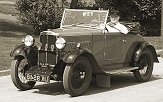|
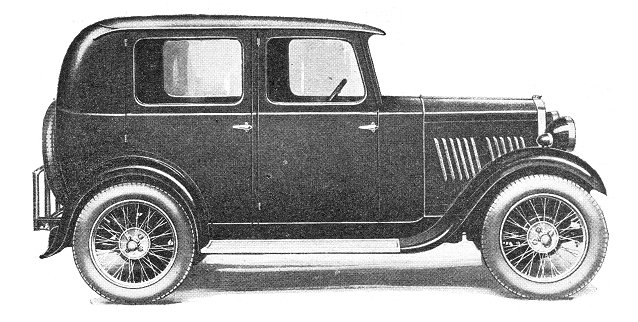
The A.J.S. saloon follows modern lines.
Arduous experimental work and
careful testing have been brought to a
successful issue, and the long-expected A.J.S.
car is now actually being produced. A. J.
Stevens and Company (1914) Limited, is a
progressive firm of the very highest standing in
the motor cycle industry; indeed, only a week or
so ago it again added to its laurels by winning
the Lightweight T.T. race in the Isle of Man.
Hence it is expected that a
small car produced by such a maker will most
certainly be a sound engineering job. The new
car, however, is definitely not intended as a
speed machine. It is the family man’s utility
vehicle, for town work or touring, large in the
body, with plenty of head and leg room,
economical enough in engine size to cut running
expenses down to a minimum, yet sufficiently
powerful to give a good performance without
constant gear changing.
Besides having a good
appearance, the new A.J.S. car has some
individual points: the seating positions are not
too low; there is plenty of leg room; there are
wells in the back floorboards to give even more,
and the instrument board occupies only the
centre of the scuttle, so that tall men in the
front seats are not in danger of barking their
knees.
| The mechanical specification
includes a rigid and compact engine,
with a three-bearing crankshaft,
side valves, and a special form of
combustion chamber which gives power
and flexibility without harshness,
an extra large fuel tank carried on
the back of the frame, half-elliptic
springs, Silentbloc bushes for the
spring anchorages, shock absorbers
for both front and rear axles, a 12
volt lighting set with big headlamps
having electric dip-and-switch
control, wire wheels, furniture hide
upholstery, and chromium plating.
The A.J.S. will be produced first
as a four-seater, four door,
fabric-covered saloon, offered
complete at £230. |
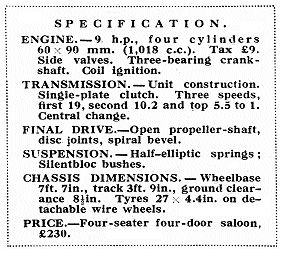 |
Outwardly the car is of reserved aspect with
a good finish, and well-balanced lines from the
chromium-plated radiator, with its central bar
at the front, to the folding luggage grid of
neat oval section tubing at the rear. The wings
are well-domed, fit closely without showing
unsightly gaps above the tyres, and should be
efficient in reducing the need for cleaning to a
minimum.

Doors of more than normal width make entry
into front or rear compartments easy. Separate
front seats with tilting backs are provided, and
with the aid of a spanner they can be adjusted
to any one of four positions. Drop windows will
be fitted to all four doors, the windscreen is a
single panel with an outrigger method of locking
it in position when open, and having screw
clamps to lock it in the closed position. The
vacuum operated screen wiper is carried on the
bottom edge of the screen, which arrangement
gives better vision in rain, and it is
indicative of the care devoted to details that
the suction tubing is of copper built into the
body, and not rubber.

Armrests are provided for
the wide rear seat - the whole body is schemed
with the idea that it will hold four six-foot
men in comfort - the rear window is wide and has
a blind controlled by the driver. Mention has
already been made of the compact central
instrument board; this component is illuminated
by concealed lamps from behind, and includes an
ignition lock as well as a control for reducing
the air supply to the carburettor when starting
from cold. There is also a control within reach
of the driver’s hand for shutting the cork-faced
fuel tap. The fuel feed is by an Autovac, and,
of course, it is an advantage to have the tank
at the back of the car because it can be large,
thus giving a good radius of action without
refilling; in addition, the space in the scuttle
is left free, and there is little likelihood of
a smell of petrol in the body. Incidentally, the
8 gallon tank is suspended at three points on
trunnions and is therefore free from the
possibility of distortion. It has a contents
gauge in the top, close to the filler spout, and
is neatly encased at the back by a
stove-enamelled cover plate.
Advantage has been taken of
the freedom of the scuttle to build into it,
under the bonnet, a really large locker for
tools. One important point in the construction
of the dash and scuttle is that the assembly
forms part of the chassis and not of the body,
so that the body can easily be dismounted at any
time without disturbing any electrical wiring.
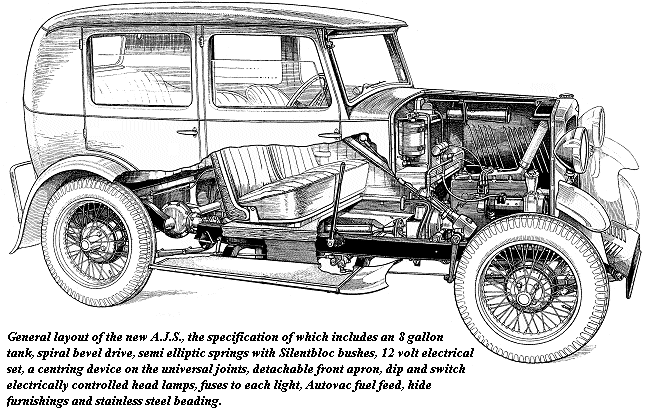
Dealing with the mechanical
aspect of the machine, the engine, which
develops 24hp. at 3,000r.p.m. is an entirely new
design of straightforward character, but
possessed of some special detail features. It is
rated at 8.9hp., and comes into the £9 tax
class, the bore being 60mm and the stroke 90mm
(1,018c.c.). The four cylinders and the greater
part of the crank case are cast in one block,
the case being carried down well below the
centre line of the crankshaft, so that the
support for the three main bearings is
particularly stiff. The shaft is dynamically
balanced during manufacture. A pressed steel
sump is employed to close the base of the
engine.
Side valves of special
quality steel are employed, and are operated
through mushroom-ended adjustable tappets of
cast iron, with faces chilled in a special
manner. The combustion chambers are designed in
conformity with the Whatmough principles of
streamline gas flow, the shape being depicted in
one of the accompanying sketches. The result of
this shape is to allow a compression ratio of
5.75 to 1 to be used, thus giving plenty of
power, but avoiding any tendency towards
detonation or ‘pinking’ and giving very smooth
running, besides an ability to pull down to
extraordinarily low speeds without rough
running.
Actually, the car can be driven
up a slope until the engine nearly stops, but
there is no thumping. This means that top gear
can be used almost entirely in traffic, the need
for gear changing, except after actually
stopping, being at a minimum. Great care has
been taken with the cooling system, which is on
the thermo-syphon principal. Water spacing is
given between all four cylinder barrels, and the
valve ports are arranged so that the metal of
their walls is entirely surrounded by water. The
flow enters the block on the valve side, is
graduated to pass evenly around the valve seats
and ports, proceeds afterwards up to the head
and then returns to the large radiator. There
are no thin divisions in the cylinder head
gasket; the head is held down by no fewer than
eighteen bolts, and the general design is
particularly good. Decarbonising should be easy,
and also not often necessary.
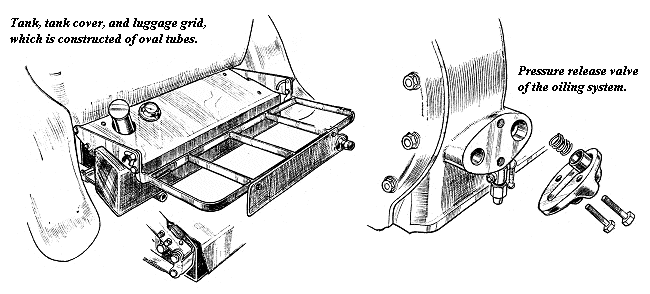
There is special interest in the
gas distribution system. The exhaust manifold
has in its centre a pocket to retain heat. This
pocket is carried downward and meets the centre
of the inlet manifold. The gas mixture from the
Solex carburettor plays on to the wall of the
pocket and is warmed, after which it proceeds
through partially insulated pipes up to the
inlet valves. The system works well and gives
that capacity to open the accelerator wide and
suddenly, in order to obtain clean acceleration
away from a low speed on top gear.
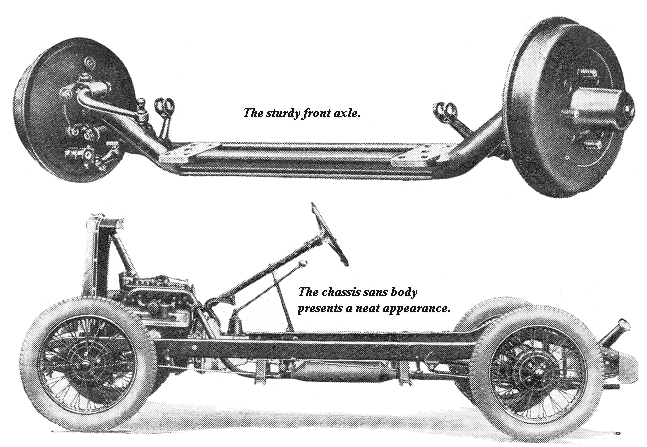
Like the rest of the
design, the lubrication of the engine is well
arranged. A gear pump of unusually large size is
driven from the centre of the camshaft. It draws
oil from the big cylindrical filter in the sump,
via a non-return valve, and then delivers it
under pressure through large diameter machined
oilways to the three main bearings and the big
ends, to the three camshaft bearings, and to the
timing chain. The sump contains six pints. A
gauze tray over the sump filters the oil a
second time before it returns into circulation.
The cylindrical filter can be detached downwards
from the bottom of the sump for cleaning
purposes. A dipstick in the side of the sump is
used for testing the oil level, and the oil
filter is placed high up at the front of the
engine.
Returning again to the
moving parts of the engine: the connecting rods
are of nickel steel and have the gudgeon pins
fixed in their small ends. Pistons of special
aluminium alloy have three rings in the head and
a scraper ring. The alloy permits a close piston
fit. At the front of the engine block is a
compartment containing the duplex roller chain,
which provides a triangulated drive from the
camshaft to the camshaft wheel and the dynamo.
The last-mentioned component is mounted high up
in a position where it is accessible, and is
arranged so that it can be swung bodily for
adjusting the chain tension. On the remote end
of the dynamo spindle is a vertical drive to the
contact breaker and distributor of the coil
ignition set.
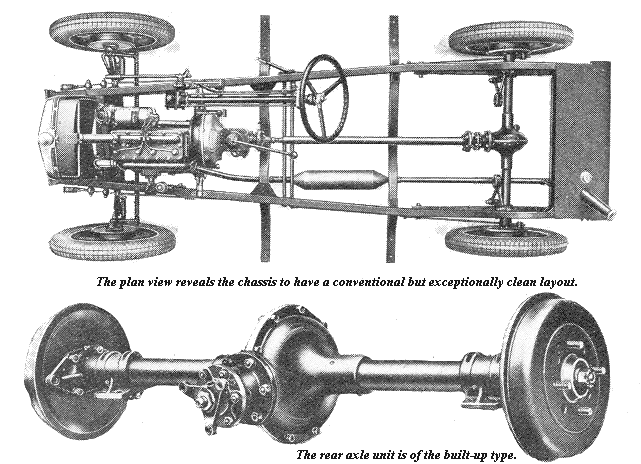
In a casing at the rear of the
engine is the flywheel, which contains a single
dry-plate clutch. The driven member of this is
radially slotted, and the segments are set
slightly out of plane to give a sweet first
engagement when moving away from rest. Clutch
adjustment is made through a cover plate, there
being set-pins for the purpose in each of the
three toggle arms which control disengagement.
There are six radially placed clutch springs
which are adjustable. Bolted to the flywheel
housing is the three-speed gearbox of normal
design, having a central change, and an enclosed
drive for the speedometer. Oil is filled into
the box through a plug at the top, a second plug
at the side being undone during the process, so
as to prevent over filling.
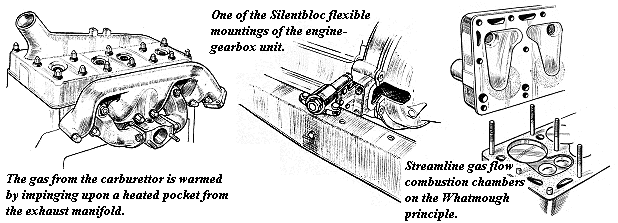
Drive is transmitted to the
built-up type rear axle through a massive
tubular propeller shaft with a splined
telescopic slide at the forward end, and with
Hardy disc flexible couplings at both ends.
These couplings have ball centring sockets which
are automatically lubricated. Inside the centre
casing of the rear axle is a spiral-bevel final
drive and a bevel differential. Semi-floating
axle shafts are used. The brake drums, both
front and rear, are carried by the wheel bolts,
and are easily removable for inspection of the
shoes - a matter of no small convenience to the
owner. The rear hub brackets and bearings are
also very accessible.
Expanding shoe brakes are
fitted to all four wheels, and are operated
through tie rods and levers. Adjustment is
carried out through an individual setting on
each brake bracket. There is no compensation. To
comply with legal regulations, the front and
rear sets are operated independently, the
right-hand lever applying the rear set, while
the pedal applies the front brakes; but there is
a trip link which transmits the movement of the
cross-shaft of the front brakes to the similar
cross-shaft which operates the rear brakes, the
result being that depression of the pedal
applies all four brakes simultaneously.
There is an unusual type of
steering gear, which in practice proves very
light and pleasant to handle, whilst a fair
amount of caster action makes for steadiness.
The gear consists of a worm mounted on the lower
end of the steering shaft, which passes through
a nut carried in a fork mounted upon the spindle
of the steering drop lever. At the top of the
column is a self-aligning ball bearing. This
gear works very freely; it precludes, however,
the fitting of engine controls at the centre of
the steering wheel, so these controls are very
neatly mounted on the column beneath the wheel.
 |
Practically
straight-sided, inclining inwards
towards the front, the channel
section side members of the frame
are stiff, and are braced by four
cross members. The middle members
are attached below the sides and
pass underneath the shaft.
It will be
realised that the detail design of
the car has been carefully thought
out; hence this newcomer may be
expected to render a good account of
itself.
This new car is
on-view at the showrooms of H.
Taylor and Company Limited, 49
Sussex Place, S.W.7. The London
agents. |
|
